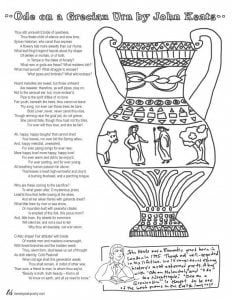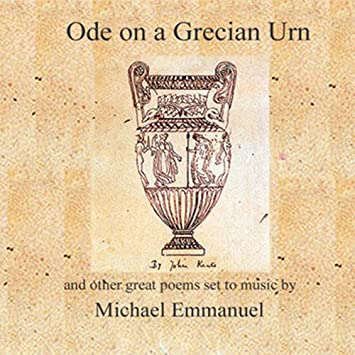Introduction: John Keats’ famous poem ‘Ode on a Grecian Urn‘ was composed in the month of May 1819. John Keats was greatly impressed by Greek art, painting and literature. He was very fond of Greek plays and epics of Homer.
Keats used to study Greek legends and seeing various pieces of Greek sculptures, which were available in the British Museum in his time.
John Keats was not inspired by any ancient Greek work to compose ‘Ode on a Grecian Urn’. It was Lord Elgin, who went to Athens in 1812, and brought a collection of marble pieces, which were preserved in British Museum.
Since these marble pieces were brought to England by Lord Elgin; that is why known as ‘Elgin Marbles’. John Keats often visited the British Museum with the purpose of watching these marble pieces. These marble urns impressed him very much.
There were some patterns, decorations, designs and figures presenting important aspects of wealthy Greek life, art and culture. It was Keats’ imaginative brain, after seeing marble urns, he portrayed a living picture of Greek life in front of his readers through ‘Ode On a Grecian Urn’.
A short summary of the poem
Table of Contents
In the first stanza of the poem, Keats, directly addresses the urn. He says that the urn is wedded to witness, and is not touched by anyone else. It is nursed by silence and slow passing time. The earn is a historian that is capable of telling a happy story in a far better way than a poet (Keats).
The poet again asks the Grecian Urn’ about the story narrated on her; if it is about Greek god and goddesses or about the man or about both. Who is god’s that are presented on the urn? A shy maiden is trying to escape from the passionate lover that is following her madly.
There is a figure of piper engraved on the urn, and he seems to be piping songs. These songs can not be heard by anyone but are more enjoyable from audible songs. That is why the poet wishes to the continuity of piper,s song for the comfort of the soul.
The trees neither can shed its leaves nor the young man can stop his song. The bold lover who is chasing the girl to kiss her and is very near, can not kiss her. The girl will remain young and beautiful and the lover will love her always.
The boughs of the trees are very happy because their leaves will never shed and there will be spring forever. The melodist will be always in a pleasant mood. Without any exhaustion, he always sings new songs every time
On the earn, there is a depiction of religious activities as well. Some people are coming for sacrifice on a green altar. The priest, that seems very mysterious, is bringing a young cow on the altar. The young cow is decorated very well.
It seems that the young cow is complaining to God against the priest. There is a little town near the river or the sea, or the village is in the mountains with the peaceful citadel. All the people are gone from the town to make sacrifices at this auspicious morning.No one will come and will tell the reason for the town,s emptiness and the town will be empty forever.
In the final stanza of ‘Ode on a Grecian Urn’, John Keats’, praises the point of view Greek people about life. They were fond of cute things and led a life that was full of affection, sympathy. There was also no lack of ceremonies that were full of pleasant activities.
The poet once again presents the Greek life through the Grecian urn. The urn is a Greek work of art and appears quite beautiful. It is a witness of Greek people’s fair attitude towards life. The men and maidens are embroidered on the urn with boughs of the tree in their background and grass can be seen under their feet.
Though, the urn is silent yet tells too much about Greek life. The Grecian urn contains the history of pastoral life and has silently delivered its message in all ages. when the present age will pass, and the new generation will come with its problems and sorrows, the Grecian urn will give the message of happiness through Greek culture.
It’s mean that the urn will work as a problem- healer in every age. ‘Beauty is truth, truth beauty’; this is the important fact of this world, necessary to know for all human beings.
The message of the poem
John Keats has painted a moving picture of ancient Greek manners and culture through Grecian urn. Through his poem, we see a life that is free of melancholy. The lovers and beloved are busy in their life. The singer is free of every type of tension.
In the same way, the people of the town are performing religious duties, with enthusiasm and happiness. A man who is suffering from sorrows should follow the Greek way of life to be happy in this universe. Probably, “imitating’ simple Greek way of life’ for the purpose of solving daily life problems” is the message of ‘Ode on a Grecian Urn’
The theme of change and permanence
The activities that are depicted on the urn always will remain the same in contrast to human life. The lover will be chasing its beloved forever and never stop to love her. The trees will be never dry; in the same way, the villagers that are out of their town to perform religious sacrifices will never return to their town.
There will be no change in these activities in contrast to daily human life. The work of art is permanent and human life is not so as. That is why art is far superior to human life.
Keats’ philosophy
In the Ode, the poet has smartly mentioned his philosophy of life. According to him, beauty and truth can not be separated from each other. A beautiful thing must be true, and truth must be beautiful. The same idea has been mentioned in the last two lines of the poem:
‘ “Beauty is truth, truth beauty” – that is all
He knows on the earth, and all ye need to know.“
Technical aspects of the “Ode on a Grecian Urn.”
John Keats’ poem is not only rich in its content, but it is also rich in various technical aspects; that is described below:
Structure: ‘Ode on a Grecian Urn’ is composed of five stanzas. Every stanza is of ten lines; that can be further divided into a ‘quatrain’ and a ‘ sets’.
Language and diction
Keats has used the language that attracts the reader every time when he reads the Ode. It is his mastery of the language that every scene which is engraved on the Grecian urn; seems watched by us through our own eyes; when we read the poem.
John Keats has proved his genius by using ‘glittering phrases’ such as; ‘trodden weed’, ‘cold pastoral’, ‘sylvan historian’, ‘foster-child’,’ a flowery tale’, and ‘leaf- fringed legend’ etc.
Use of archaic word such as, ‘thou, thy’ and ‘ye’ etc. are helpful in increasing the poem’s beauty.
Use of figure of speech
John Keats has applied a figure of speech called metaphor on some places in the poem. One example is given below form opening lines of ‘Ode on a Grecian Urn’:
‘Thou still unravished bride of quite a ness,
Thou foster-child of silence and slow time,
Sylvan historian, who canst thus express
A flowery tale’ more sweetly than our rhyme.’
Conclusion:
‘Ode on a Grecian Urn’ is a prominent poem of the Romantic era. Not only its subject matter, but its language and poetic devices will influence the readers and invite them to read the poem again and again.




